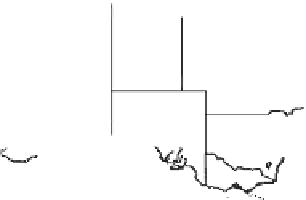Geoscience Reference
In-Depth Information
60
100
120
100
100
80
80
40
80
Median = 35 km
Mode = 53 km
n
= 307
Median = 15 m
Mode = 30 m
n
= 207
60
60
60
40
40
20
40
20
20
20
0
0
0
0
0
40
80
120
160
200
240
0
60
120
180
240
300
360
420
480
Length (km)
Vertical Displacement (m)
(c)
(d)
100 (227)
60 (500)
Length (km)
Vert. Displ. (m)
0 (1.6)
0 (0.1)
(e)
(f )
Neotectonic Domain
Neotectonic Domain
D2
D3
D4
D5
D6
D2
D3
D4
D5
D6
D1
D1
200
140
120
160
100
120
80
60
80
40
40
20
0
0
min
max
med
n
2.7
2.8
1.6
6.9
2.2
6
min
max
med
n
0.15
4
0.1
2.5
0.1
0.2
127
172
227
186
81.5
170
60
250
80
500
240
100
26
31
49
49
28
53
5
40
10
30
44
10
69
48
71
49
44
26
52
34
53
30
25
13
Figure 2.5 Population distributions for Australian neotectonic (a) fault length and (b) vertical dis-
placement data, with accompanying plots showing the spatial distribution of (c) fault length and
(d) vertical displacement data across the Australian continent. Interpolated surfaces in parts (a) and
(b) are constructed using the same method as
Figure 2.3
.
Grey lines indicate neotectonic domain
boundaries (cf.
Figure 2.4
)
. Data values have been scaled for gridding - values in parentheses in the
legend indicate the full range of underlying data. Box and whisker plots of (e) fault length and (f)
vertical displacement data, binned by neotectonic domain. Boxes denote 75th and 25th percentiles,
central point indicates median value, and whiskers define 90th and 10th percentiles. Data table shows
minimum, maximum, median, and number of data points (
n
) for each domain.




































































































































